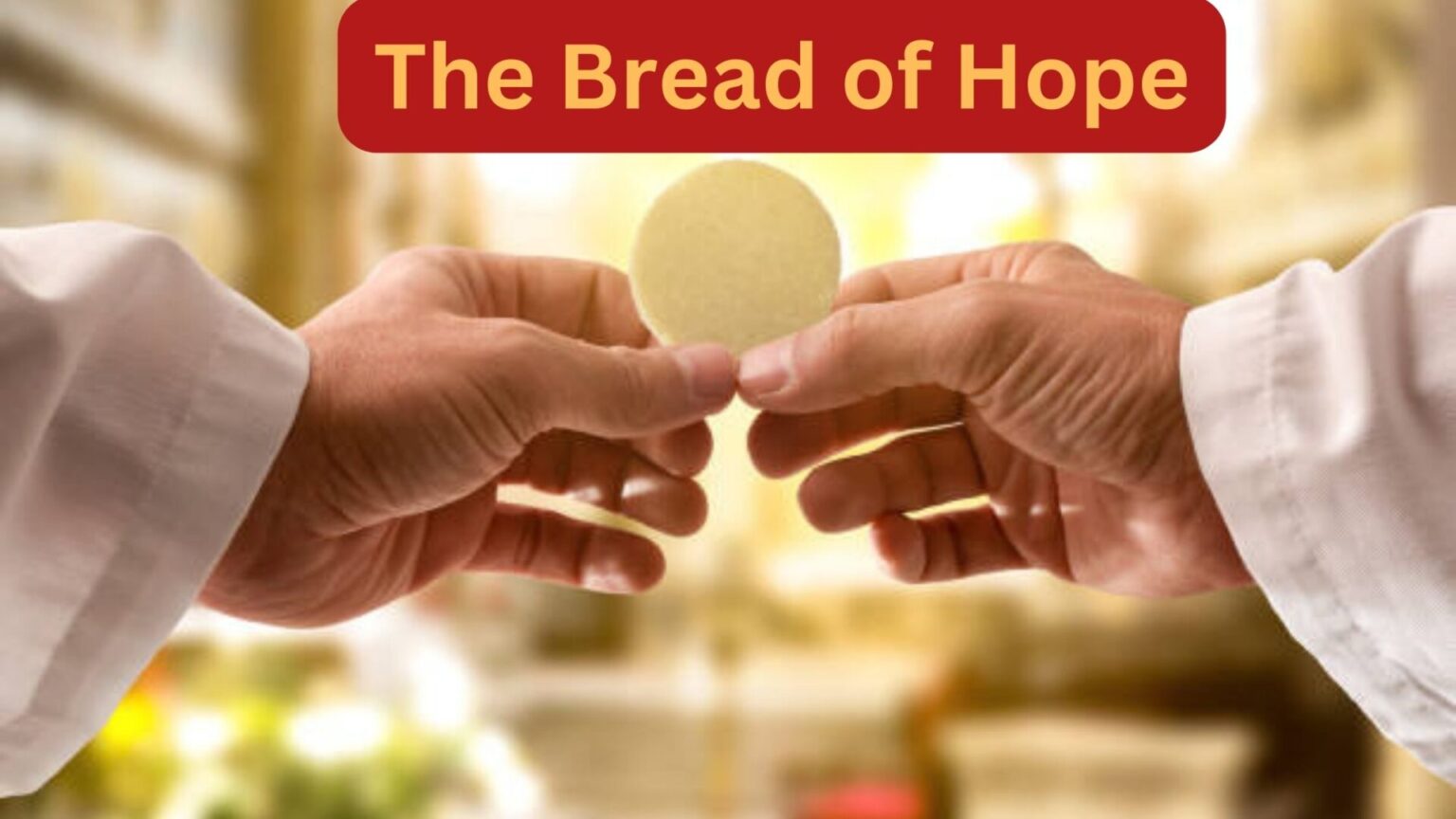Introduction:
“The Bread of Hope: Reflecting on Jesus’ Profound Statement”

In the tapestry of religious teachings, certain phrases resonate deeply, echoing across time with profound significance. Among these, Jesus’ declaration, “I am the bread of life,” stands out as a beacon of hope and spiritual nourishment. Join us as we embark on a reflective journey to unpack the layers of meaning behind this profound statement.
Unveiling Symbolism: Bread, a fundamental staple in cultures worldwide, holds symbolic weight beyond its physical form. It represents sustenance, provision, and unity. Jesus’ assertion as the “bread of life” transcends the material realm, inviting us to partake in a spiritual feast that nourishes our souls and unites us with divine purpose.
The Bread of Hope :
In a world often plagued by uncertainty and turmoil, Jesus’ words offer a sanctuary of hope. By proclaiming himself as the “bread of life,” he extends an invitation to all who hunger for meaning and purpose—a promise of sustenance that transcends earthly concerns and provides nourishment for the soul.
Reflections on Profound Truths: As we pause to reflect on Jesus’ profound statement, we delve into the essence of spiritual nourishment. Just as bread sustains the body, faith in Jesus sustains the spirit, offering a source of strength and renewal amidst life’s challenges. Through contemplation and prayer, we deepen our understanding of the eternal truths embedded in his words.
Satisfying the Soul’s Longing: Unlike temporal pleasures that leave us wanting, the spiritual nourishment offered by Jesus satisfies the deepest yearnings of the human heart. It fills the void within, providing a sense of fulfillment and completeness that transcends material desires—a taste of divine abundance that leaves us hungering for more.
“Why is Jesus’ statement ‘I am the bread of life‘ considered profound?
esus’ statement “I am the bread of life” is considered profound for several reasons:

- Metaphorical richness: In this statement, Jesus is using metaphorical language to convey a deep spiritual truth. Bread is a fundamental staple of life, providing sustenance and nourishment. By likening himself to bread, Jesus is implying that he is essential for sustaining spiritual life. Just as physical bread sustains the body, Jesus sustains the soul.
- Universal relevance: Bread is a basic necessity that transcends cultural and societal boundaries. By using bread as a metaphor, Jesus makes his message accessible to people from all walks of life. Regardless of their background or circumstances, everyone understands the importance of bread for survival. In the same way, Jesus’ message of spiritual nourishment is relevant to all people.
- Dependency on Jesus: Just as people depend on bread for physical sustenance, Jesus is suggesting that people must depend on him for spiritual sustenance. This statement underscores the centrality of Jesus in the Christian faith. According to Christian belief, true fulfillment and eternal life can only be found in a relationship with Jesus.
- Eucharistic significance: For many Christians, Jesus’ statement about being the bread of life is closely associated with the sacrament of the Eucharist (also known as Communion or the Lord’s Supper). In the Eucharist, Christians believe that the bread represents the body of Christ, broken for humanity. Therefore, Jesus’ statement takes on added significance in the context of the Eucharistic ritual, symbolizing the intimate union between Christ and his followers.
Overall, Jesus’ declaration “I am the bread of life” is profound because it encapsulates fundamental truths about spiritual sustenance, dependency on Christ, and the universal relevance of his message.
“What is the deeper meaning behind Jesus’ declaration as ‘the bread of life’
The declaration of Jesus as “the bread of life” carries several deeper meanings:
- Sustenance for the soul: Bread is a basic necessity for physical sustenance, and by likening himself to bread, Jesus implies that he provides essential nourishment for the soul. Just as physical bread satisfies hunger and sustains life, Jesus satisfies the spiritual hunger of humanity and sustains spiritual life. He offers spiritual nourishment, fulfillment, and sustenance that can’t be found elsewhere.
- Life-giving provision: Bread symbolizes provision and abundance. In declaring himself as the bread of life, Jesus indicates that he provides abundant life—life in all its fullness—as mentioned in John 10:10. Through him, believers receive not just existence but a life that is rich, meaningful, and eternal.
- Unity with believers: Bread is made from many grains brought together to form a single loaf. Similarly, Jesus’ declaration emphasizes his desire for unity with his followers. Just as the grains are unified in the bread, believers are united with Christ and with one another through their shared faith in him.
- Eternal sustenance: Physical bread satisfies temporarily, but spiritual bread—Jesus—provides eternal sustenance. Jesus offers a permanent solution to the deepest needs of humanity, addressing the longing for purpose, meaning, and connection with God.
- Eucharistic significance: For Christians, Jesus’ declaration also has significant ties to the Eucharist. In the sacrament of Communion, believers partake of bread and wine, symbolizing the body and blood of Christ. Through this ritual, believers remember Jesus’ sacrifice, receive spiritual nourishment, and are united with him and with one another in a profound way.
Overall, Jesus’ declaration as “the bread of life” encompasses themes of sustenance, provision, unity, eternal life, and the Eucharist, conveying the depth of his relationship with believers and the spiritual nourishment he offers to all who come to him in faith.
Are there parallels between ‘The Bread of Hope’ and other religious traditions?
The concept of bread as a symbol of hope and sustenance is found in various religious and cultural traditions, although the specific parallels may vary. Here are some examples:

1. **Judaism**: In Judaism, bread holds significant symbolism, particularly in rituals such as Sabbath and Passover. Challah, a braided bread eaten on the Sabbath, represents sustenance and blessings. During Passover, matzah, unleavened bread, symbolizes the haste with which the Israelites left Egypt and the sustenance provided by God during their journey in the wilderness.
2. **Islam**: In Islam, bread also holds importance as a staple food. In the Islamic tradition, there are teachings about sharing bread with others as an act of charity and hospitality. Bread is seen as a provision from Allah and sharing it is encouraged as a way to show compassion and solidarity with others.
3. **Christianity (Eucharist)**: Within Christianity, particularly in Catholicism and some other denominations, the Eucharist holds central importance. The bread and wine in the Eucharistic ritual symbolize the body and blood of Christ, providing spiritual nourishment and symbolizing the hope of eternal life through communion with God.
Conclusion:
As we reflect on Jesus’ profound statement as the “bread of hope,” let us embrace its transformative power in our lives. May we partake in this spiritual banquet with gratitude and reverence, knowing that in Jesus, we find sustenance for the soul and hope for the journey ahead. Let us cherish the timeless wisdom encapsulated in his words, finding solace and inspiration in the bread of hope that sustains us all.
FAQ
Here are some frequently asked questions (FAQs) that could be derived from the topic of the symbolism of bread in various religious traditions:
1. Why is bread significant in religious traditions?
Bread holds symbolic importance in many religious traditions as a staple food representing sustenance, provision, and communal sharing. Its symbolism often extends to themes of spiritual nourishment, unity, and hope.
2. What are some examples of bread symbolism in different religions?
– In Christianity, bread is central to the Eucharist, symbolizing the body of Christ.
– In Judaism, challah and matzah symbolize blessings and sustenance.
– In Islam, sharing bread is encouraged as an act of charity and hospitality.
– In Hinduism, bread-like items are eaten as sacred food, and grains are offered in rituals.
– In Buddhism, while not directly related to bread, teachings emphasize sustenance and right livelihood.
3. How does the symbolism of bread in different religions compare?
While the specific rituals and interpretations vary, the symbolism of bread often revolves around themes of sustenance, provision, unity, and spiritual nourishment. Each tradition emphasizes the importance of sharing, communal unity, and dependence on divine provision.
References
1. **Scholarly Journals**: Search academic databases such as JSTOR, Google Scholar, or religious studies journals like “Journal of Religion” or “Religious Studies Review” for articles discussing the symbolism of bread in various religious traditions.
2. **Books on Comparative Religion**: Look for books that explore the similarities and differences between religious symbols and rituals across different faiths. Authors like Huston Smith, Mircea Eliade, and Karen Armstrong often delve into comparative religious studies.
3. **Religious Texts and Commentaries**: Explore the sacred texts and commentaries of different religions to understand the significance of bread and its symbolism within each tradition. This includes the Bible for Christianity, the Quran for Islam, the Vedas and Upanishads for Hinduism, and Buddhist sutras for Buddhism.
4. **Websites of Religious Studies Institutes**: Many universities and religious studies institutes have websites with resources and publications related to comparative religion. Exploring their online libraries or publications might yield articles on the topic.
5. **Online Religious Forums and Discussions**: Websites like Reddit’s r/Religion or academic forums like Academia.edu often host discussions and papers related to religious symbolism and comparative religion. You may find references or recommendations from other users.






